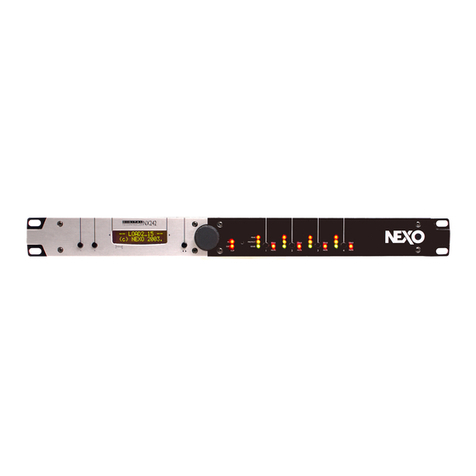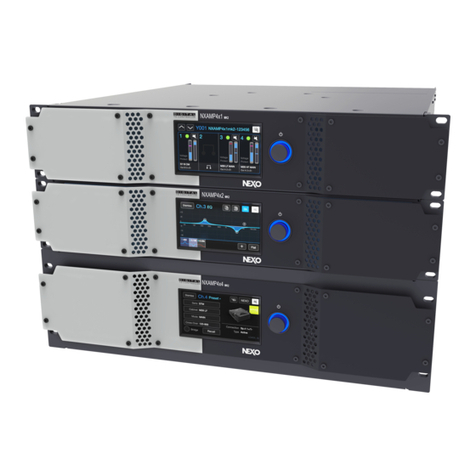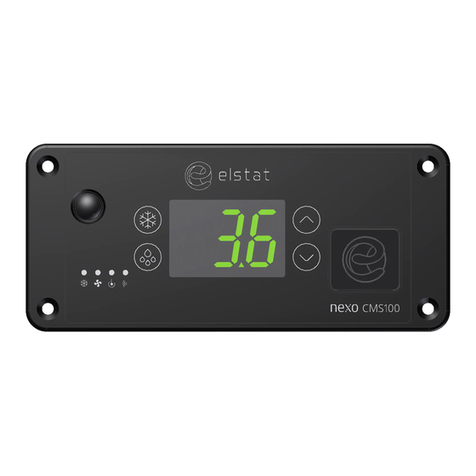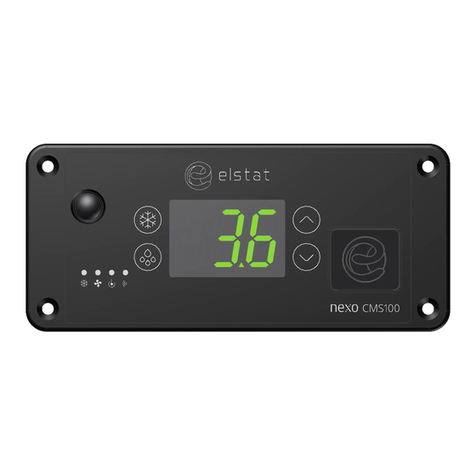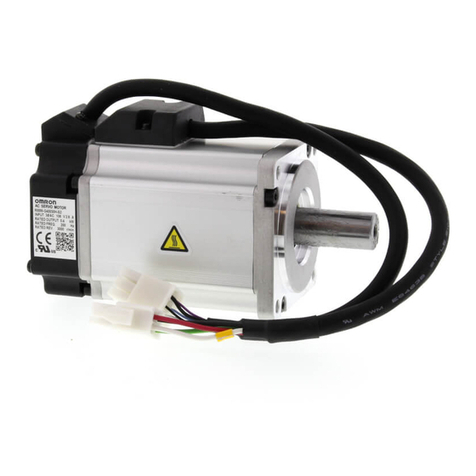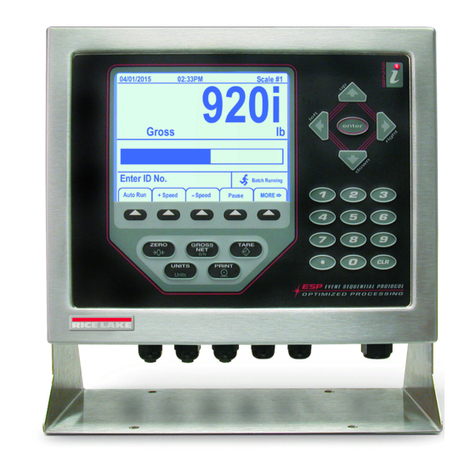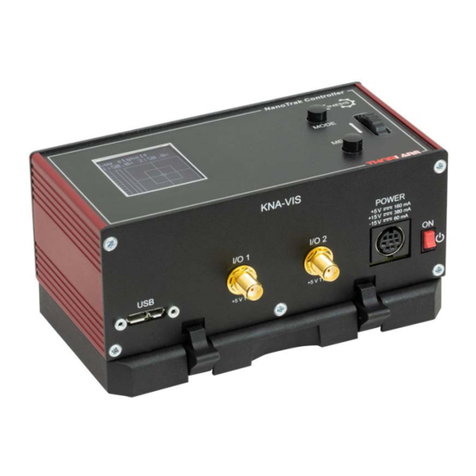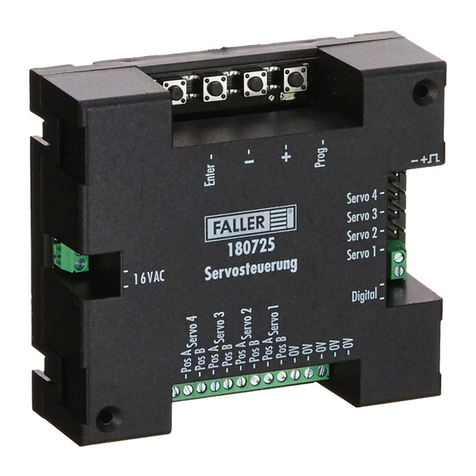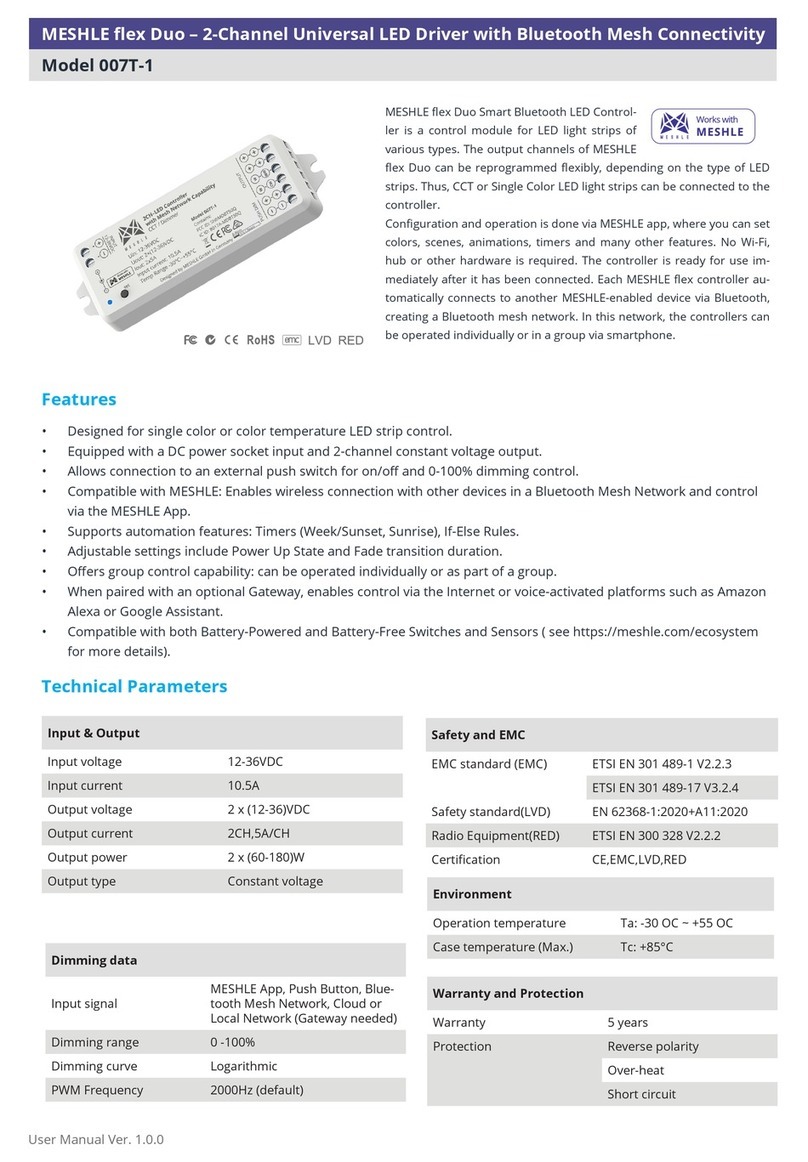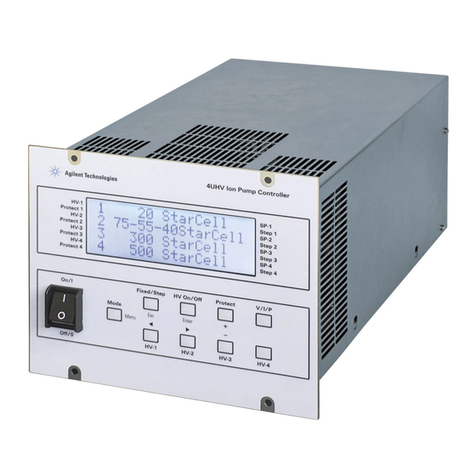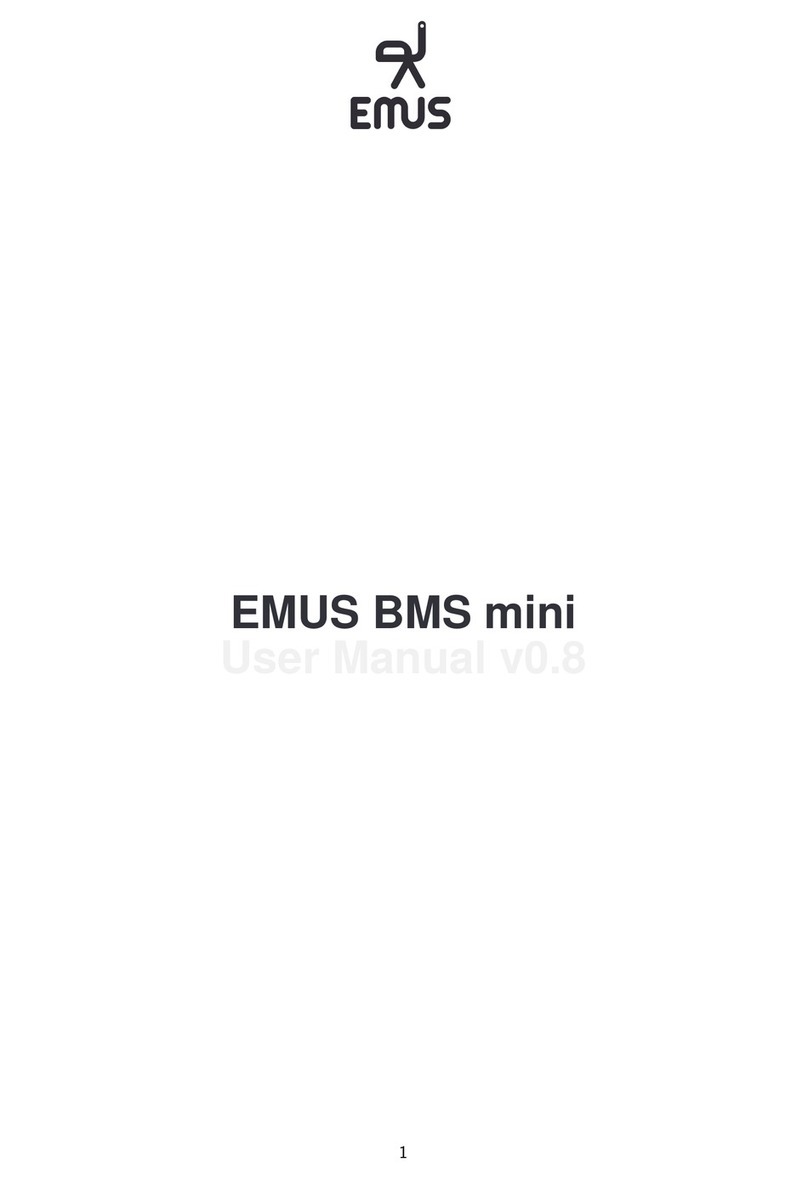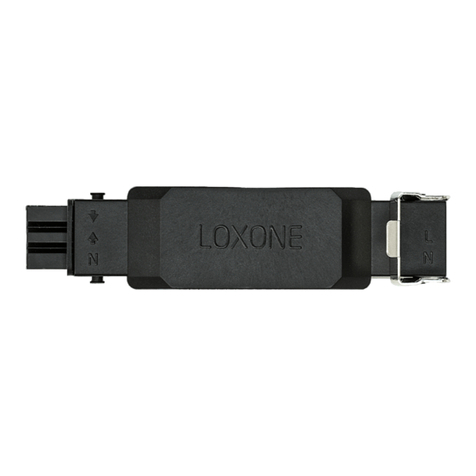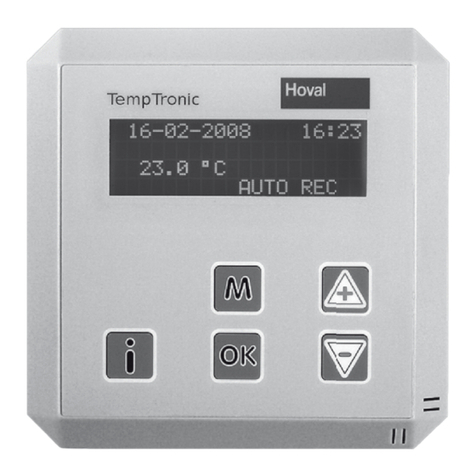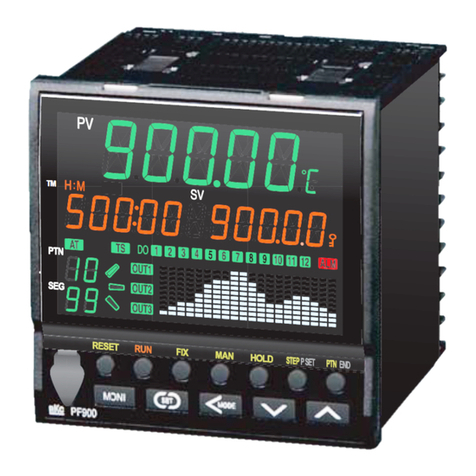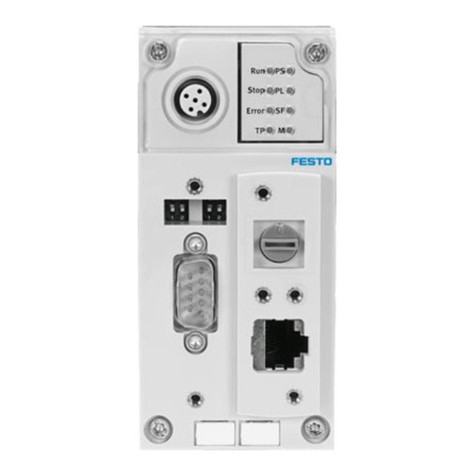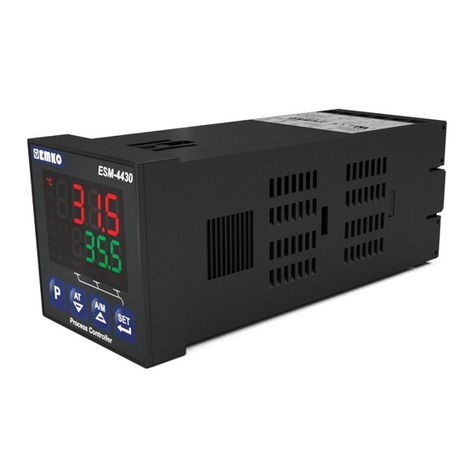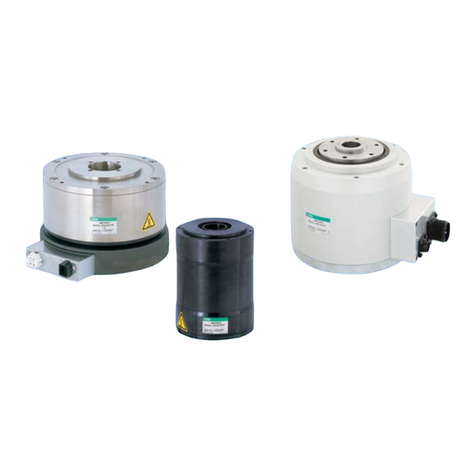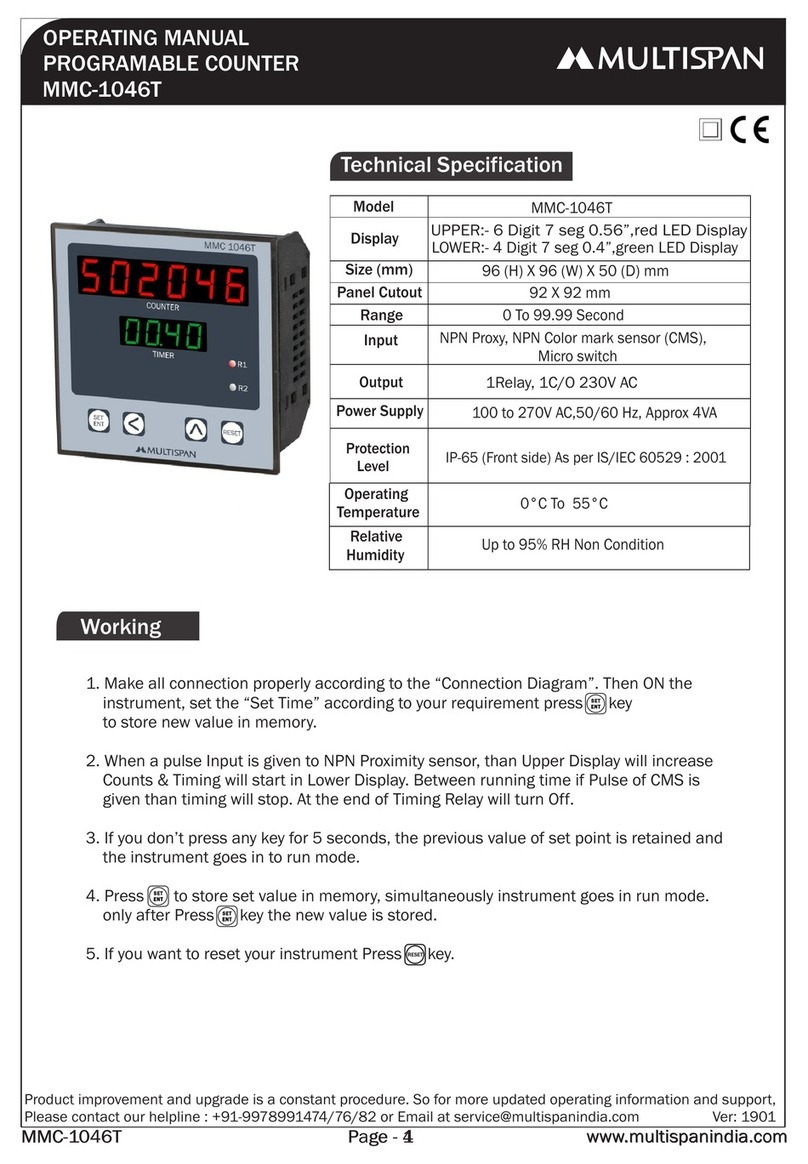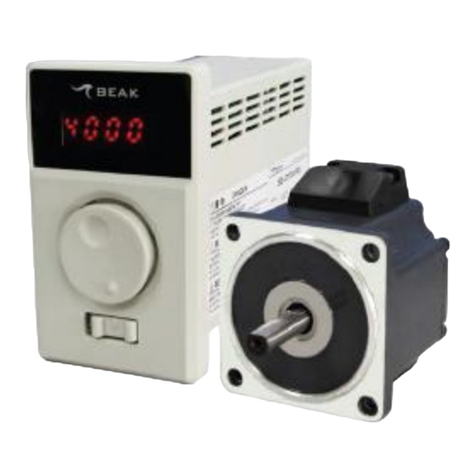Nexo NXAMP4X1 User manual

NXAMP4X1 Powered TDcontroller
User Manual v1.2 (LOAD2_48)


FCC INFORMATION (U.S.A.)
1. IMPORTANT NOTICE: DO NOT MODIFY THIS UNIT!
This product, when installed as indicated in the instructions contained in this
manual, meets FCC requirements. Modifications not expressly approved by
NEXO-SA may void your authority, granted by the FCC, to use the product.
2. IMPORTANT:
When connecting this product to accessories and/or another product use only
high quality shielded cables. Cable/s supplied with this product MUST be used.
Follow all installation instructions. Failure to follow instructions could void your
FCC authorization to use this product in the USA.
3. NOTE:
This product has been tested and found to comply with the requirements listed
in FCC Regulations, Part 15 for Class “B” digital devices. Compliance with these
requirements provides a reasonable level of assurance that your use of this
product in a residential environment will not result in harmful interference with
other electronic devices. This equipment generates/uses radio frequencies and, if
not installed and used according to the instructions found in the users manual,
may cause interference harmful to the operation of other electronic devices.
Compliance with FCC regulations does not guarantee that interference will not
occur in all installations. If this product is found to be the source of interference,
which can be determined by turning the unit “OFF” and “ON”, please try to
eliminate the problem by using one of the following measures:
Relocate either this product or the device that is being affected by the
interference.
Utilize power outlets that are on different branch (circuit breaker or fuse) circuits
or install AC line filter/s.
In the case of radio or TV interference, relocate/reorient the antenna. If the
antenna lead-in is 300 ohm ribbon lead, change the lead-in to co-axial type
cable.
If these corrective measures do not produce satisfactory results, please contact
the local retailer authorized to distribute this type of product. If you can not
locate the appropriate retailer, please contact the After Sales department of
NEXO-SA, Parc d’Activité du Pré de la Dame Jeanne, B.P. 5, 60128 PLAILLY
The above statements apply ONLY to those products distributed by NEXO-SA or
its subsidiaries.
* This applies only to products distributed in the United States of America.
IMPORTANT SAFETY INSTRUCTIONS
1 Read these instructions.
2 Keep these instructions.
3 Heed all warnings.
4 Follow all instructions.
5 Do not use this apparatus near water.
6 Clean only with dry cloth.
7 Do not block any ventilation openings. Install in accordance with the
manufacturer’s instructions.
8 Do not install near any heat sources such as radiators, heat registers,
stoves, or other apparatus (including amplifiers) that produce heat.
9 Do not defeat the safety purpose of the polarized or grounding-type
plug. A polarized plug has two blades with one wider than the other. A
grounding type plug has two blades and a third grounding prong. The
wide blade or the third prong are provided for your safety. If the
provided plug does not fit into your outlet, consult an electrician for
replacement of the obsolete outlet.
10 Protect the power cord from being walked on or pinched particularly
at plugs, convenience receptacles, and the point where they exit from
the apparatus.
11 Only use attachments/accessories specified by the manufacturer.
12 Unplug this apparatus during lightning storms or when unused for
long periods of time.
13 Refer all servicing to qualified service personnel. Servicing is
required when the apparatus has been damaged in any way, such as
power-supply cord or plug is damaged, liquid has been spilled or
objects have fallen into the apparatus, the apparatus has been exposed
to rain or moisture, does not operate normally, or has been dropped.
PRECAUTIONS
Please read carefully before proceeding. Please keep this manual in a safe place for future reference.
WARNING
Always follow the basic precautions listed below to avoid the possibility of serious injury or even death from electrical shock, short-circuiting,
damages, fire or other hazards. These precautions include, but are not limited to, the following:

Power supply/Power cord
• Only use the voltage specified as correct for the device. The required voltage is
printed on the name plate of the device.
• Use only the included power cord.
• Do not place the power cord near heat sources such as heaters or radiators, and do
not excessively bend or otherwise damage the cord, place heavy objects on it, or
place it in a position where anyone could walk on, trip over, or roll anything over it.
• Be sure to connect to an appropriate outlet with a protective grounding connection.
Improper grounding can result in electrical shock.
Do not open
• Do not open the device or attempt to disassemble the internal parts or modify them
in any way. The device contains no user-serviceable parts. If it should appear to be
malfunctioning, discontinue use immediately and have it inspected by qualified NEXO-
SA service personnel.
Water warning
• Do not expose the device to rain, use it near water or in damp or wet conditions, or
place containers on it containing liquids which might spill into any openings.
If any liquid such as water seeps into the device, turn off the power immediately and
unplug the power cord from the AC outlet. Then have the device inspected by
qualified NEXO-SA service personnel.
• Never insert or remove an electric plug with wet hands.
If you notice any abnormality
• If the power cord or plug becomes frayed or damaged, or if there is a sudden loss
of sound during use of the device, or if any unusual smells or smoke should appear to
be caused by it, immediately turn off the power switch, disconnect the electric plug
from the outlet, and have the device inspected by qualified NEXO-SA service
personnel.
• If this device should be dropped or damaged, immediately turn off the power
switch, disconnect the electric plug from the outlet, and have the device inspected by
qualified NEXO-SA service personnel.
CAUTION
Always follow the basic precautions listed below to avoid the possibility of physical injury to you or others, or damage to the device or other
property. These precautions include, but are not limited to, the following:
Power supply/Power cord
• Remove the electric plug from the outlet when the device is not to be used for
extended periods of time, or during electrical storms.
• When removing the electric plug from the device or an outlet, always hold the plug
itself and not the cord. Pulling by the cord can damage it.
• If you are using the NXAMP4x4, be sure to plug each power cord into separate
branch circuits employing separate service grounds. Plugging into the same circuit
can result in electrical shock.
• To disconnect the NXAMP4x4 from the mains, unplug both power cords.
Location
• When transporting or moving the device, always use two or more people.
Attempting to lift the device by yourself may damage your back, result in other
injury, or cause damage to the device itself.
• Before moving the device, remove all connected cables.
• When setting up the device, make sure that the AC outlet you are using is easily
accessible. If some trouble or malfunction occurs, immediately turn off the power
switch and disconnect the plug from the outlet. Even when the power switch is turned
off, electricity is still flowing to the product at the minimum level. When you are not
using the product for a long time, make sure to unplug the power cord from the wall
AC outlet.
• If this device is to be mounted in an EIA-standard rack, leave the back of the rack
open and make sure that it is at least 10 cm away from walls or surfaces. Also, if this
device is to be mounted with devices that tend to generate heat, such as power
amplifiers, be sure to keep an adequate gap between this device and the heat-
generating devices or install ventilation panels to prevent high temperatures from
developing inside this device.
Inadequate ventilation can result in overheating, possibly causing damage to the
device(s), or even fire.
• Do not use the device in a confined, poorly-ventilated location. If this device is to be
used in a small space other than an EIA-standard rack, make sure that there is
adequate space between the device and surrounding walls or other devices: at least
10 cm at the sides, 15 cm behind and 40 cm above. Inadequate ventilation can result
in overheating, possibly causing damage to the device(s), or even fire.
• Do not expose the device to excessive dust or vibrations, or extreme cold or heat
(such as in direct sunlight, near a heater, or in a car during the day) to prevent the
possibility of panel disfiguration or damage to the internal components.
• Do not place the device in an unstable position where it might accidentally fall over.
• Do not block the vents. This device has ventilation holes at the front/rear to prevent
the internal temperature from becoming too high. In particular, do not place the
device on its side or upside down. Inadequate ventilation can result in overheating,
possibly causing damage to the device(s), or even fire.
• Do not use the device in the vicinity of a TV, radio, stereo equipment, mobile
phone, or other electric devices. Doing so may result in noise, both in the device itself
and in the TV or radio next to it.
Connections
• Before connecting the device to other devices, turn off the power for all devices.
Before turning the power on or off for all devices, set all volume levels to minimum.
• Use only speaker cables for connecting speakers to the speaker jacks. Use of other
types of cables may result in fire.
Maintenance
• Inspect the cooling fans and clean them periodically. Dust and dirt can seriously
degrade the effectiveness of the cooling fan and result in malfunction or fire.
• Remove the power plug from the AC outlet when cleaning the device.
Handling caution
• When turning on the AC power in your audio system, always turn on the device
LAST, to avoid speaker damage. When turning the power off, the device should be
turned off FIRST for the same reason.
• Do not insert your fingers or hands in any gaps or openings on the device (vents…)
• Avoid inserting or dropping foreign objects (paper, plastic, metal, etc.) into any
gaps or openings on the device (vents, etc.) If this happens, turn off the power
immediately and unplug the power cord from the AC outlet. Then have the device
inspected by qualified NEXO-SA service personnel.
• Do not use the device for a long period of time at a high or uncomfortable volume
level, since this can cause permanent hearing loss. If you experience any hearing loss
or ringing in the ears, consult a physician.
• Do not rest your weight on the device or place heavy objects on it, and avoid use
excessive force on the buttons, switches or connectors.
• Do not use this device for any purpose other than driving loudspeakers.

XLR-type connectors are wired as follows (IEC60268 standard): pin 1: ground, pin 2: hot (+), and pin 3: cold (-).
Use only Neutrik NL4 plugs for connecting Speakon connectors.
NEXO-SA cannot be held responsible for damage caused by improper use or modifications to the device or data that is lost or destroyed.
• Always turn the power off when the device is not in use.
• The performance of components with moving contacts, such as switches, volume controls, and connectors, deteriorates over time. Consult qualified NEXO-SA service
personnel about replacing defective components.
• If you do not intend to rack-mount the NXAMP, attach the included rubber feet to the bottom surface of the device.
IMPORTANT NOTICE FOR THE UNITED KINGDOM
Connecting the Plug and Cord
WARNING: THIS APPARATUS MUST BE EARTHED
IMPORTANT. The wires in this mains lead are colored in accordance with the following
code:
GREEN-AND-YELLOW: EARTH
BLUE : NEUTRAL
BROWN : LIVE
As the colors of the wires in the mains lead of this apparatus may not correspond
with the colored markings identifying the terminals in your plug proceed as follows:
The wire which is colored GREEN-and-YELLOW must be connected to the terminal in
the plug which is marked by the letter E or by the safety earth symbol or colored
GREEN or GREEN-and-YELLOW.
The wire which is colored BLUE must be connected to the terminal which is marked
with the letter N or colored BLACK.
The wire which is colored BROWN must be connected to the terminal which is marked
with the letter L or colored RED.
• This applies only to products distributed in the United Kingdom.
COMPLIANCE INFORMATION STATEMENT (DECLARATION OF CONFORMITY PROCEDURE)
1) This device may not cause harmful interference, and
2) This device must accept any interference received including interference that may cause undesired operation. See user manual instructions if interference to
radio reception is suspected.
* This applies only to products distributed in the United States of America.
EUROPEAN MODELS
Purchaser/User Information specified in EN55103-1 and EN55103-2.
Inrush Current: 16 A
Conforms to Environments: E1, E2, E3 and E4.
This mark indicates a dangerous electrically live terminal. When connecting an external wire to this terminal, it is necessary either to
have a “a person who have received appropriate guidance on handling” make the connection or to use leads or a cord that have been
manufactured in such way that the connection can be made simply and without problem.

TABLE OF CONTENT
TABLE OF CONTENT
TABLE OF CONTENT ......................................................................................................................................................... 6
NXAMP4X1 VERSUS NX242: WHAT’S NEW ? ............................................................................................................10
WHAT’S REMAINING THE SAME? .......................................................................................................................................... 10
DSP CORE ...............................................................................................................................................................................10
LEVEL AND LATENCY .............................................................................................................................................................. 10
SOFTWARE ..............................................................................................................................................................................10
WHAT’S CHANGED?............................................................................................................................................................... 10
INTEGRATED AMPLIFIER .......................................................................................................................................................... 10
COMPUTING RESOURCES ......................................................................................................................................................... 11
FOUR SEPARATE INPUTS .......................................................................................................................................................... 11
POWER SUPPLY........................................................................................................................................................................ 11
ETHERSOUND™OPTIONAL BOARD.......................................................................................................................................... 11
USER INTERFACE..................................................................................................................................................................... 11
QUICK START.................................................................................................................................................................... 12
FRONT PANEL DESCRIPTION.................................................................................................................................................. 12
(1) POWER SWITCH.................................................................................................................................................................. 12
(2) AMPLIFIER INDICATORS ..................................................................................................................................................... 12
(3) LCD DISPLAY .................................................................................................................................................................... 13
(4) ENCODER...........................................................................................................................................................................13
(5) NAVIGATION BUTTONS (A &B)......................................................................................................................................... 13
(6) VOLUME INDICATORS ........................................................................................................................................................ 13
(7) MUTE BUTTONS ................................................................................................................................................................. 13
(8) SELECT BUTTONS............................................................................................................................................................... 13
(9) CHANNEL INDICATORS....................................................................................................................................................... 14
(10) AIR INTAKES.................................................................................................................................................................... 14
(11) SCREW HOLES FOR HANDLES ........................................................................................................................................... 14
BACK PANEL DESCRIPTION.................................................................................................................................................... 15
(1) MAINS CONNECTORS ......................................................................................................................................................... 15
(2) BALANCED AUDIO INPUTS WITH LINK ................................................................................................................................15
(3) EXPANSION SLOT ............................................................................................................................................................... 15
(4) POWER OUTPUTS................................................................................................................................................................ 15
(5) RS-232 PORT ..................................................................................................................................................................... 15
(6) GPIO PORT ........................................................................................................................................................................15
(7) REAR END MOUNTING HOLES ............................................................................................................................................. 16
BASIC FUNCTIONS .................................................................................................................................................................. 16
RESET .....................................................................................................................................................................................16
SELECTING CABINET FAMILY................................................................................................................................................... 16
SELECT YOUR CABINET SET-UP................................................................................................................................................ 16
USING THE AMPLIFIER WITHOUT THE TDCONTROLLER FUNCTIONALITY ................................................................................. 17
BACK TO DEFAULT .................................................................................................................................................................. 17
AUTO SAVE ............................................................................................................................................................................. 17
ENTER THE DOWNLOAD MODE................................................................................................................................................. 17
WHAT’S INSIDE THE CARTON BOX ........................................................................................................................... 18
PAGE 6 OF 80

TABLE OF CONTENT
SETTING-UP ADVICE.......................................................................................................................................................19
EARTH CONNECTION..............................................................................................................................................................19
MAINS SETTING......................................................................................................................................................................19
MOUNTING THE NXAMP4X1IN A RACK (GROUNDING,SHIELDING &SAFETY ISSUES) .....................................................19
USING THE NXAMP4X1WITHOUT A RACK ..........................................................................................................................21
FUSES......................................................................................................................................................................................21
ELECTROMAGNETIC ENVIRONMENTS ...................................................................................................................................21
ANALOGUE INPUT SIGNAL CABLES ........................................................................................................................................21
NXAMP4X1POWER OUTPUTS WIRING .................................................................................................................................23
GENERAL DESCRIPTION................................................................................................................................................24
GLOBAL ARCHITECTURE .......................................................................................................................................................24
POWER SUPPLY BLOCK ...........................................................................................................................................................24
ANALOG INPUT BLOCK ............................................................................................................................................................25
CONTROL BLOCK .....................................................................................................................................................................25
POWER AMPLIFIER BLOCKS......................................................................................................................................................26
POWER OUTPUTS BLOCK ..........................................................................................................................................................26
USER INTERFACE BLOCK..........................................................................................................................................................27
COMMUNICATION BLOCK ........................................................................................................................................................27
EXPANSION SLOT BLOCK .........................................................................................................................................................29
BLOCK DIAGRAM DESCRIPTION ................................................................................................................................30
PATCHING AND ROUTING (1) .................................................................................................................................................31
DELAY &POLARITY INVERSION (2) ......................................................................................................................................31
FACTORY SET-UP DELAY .........................................................................................................................................................31
USER SET-UP DELAY ................................................................................................................................................................31
EQUALISATION &FILTERING................................................................................................................................................31
SUBSONIC AND VHF FILTERING (3).........................................................................................................................................31
EQUALISING WIDEBAND ACOUSTICAL RESPONSE (3) ...............................................................................................................32
USER SET-UP,ARRAY EQ (4) ....................................................................................................................................................32
EQUALISING SINGLE COMPONENT RESPONSE AND NXSTREAM PROCESSING (5) ...................................................................32
CROSSOVER SECTION (6) .........................................................................................................................................................32
POST PROTECTION EQ AND LOW PASS (27) (28) ......................................................................................................................32
GAIN SECTION (29)..................................................................................................................................................................32
PROTECTIONS ........................................................................................................................................................................33
SOURCE SIGNALS FOR PROTECTION ALGORITHMS (25) ............................................................................................................33
DISPLACEMENT CONTROL (7) (8) (9) .......................................................................................................................................33
MECHANICAL STRESS CONTROL (10) (11) ...............................................................................................................................33
HF DISPLACEMENT CONTROL (12)...........................................................................................................................................34
HF ACCELERATION CONTROL (13)...........................................................................................................................................34
GLOBAL PURPOSE VCEQ (14).................................................................................................................................................34
LOUDSPEAKER PEAK LIMITERS(15) .........................................................................................................................................34
TEMPERATURE CONTROL (16) (17)..........................................................................................................................................34
INTERCHANNEL REGULATION (19)...........................................................................................................................................35
AMPLIFIER PEAK CURRENT LIMITER (20) .................................................................................................................................35
AMPLIFIER INTEGRATE CURRENT LIMITER (21)........................................................................................................................35
AMPLIFIER PEAK VOLTAGE LIMITER (22).................................................................................................................................35
AMPLIFIER SHORT CIRCUIT DETECTOR (24) .............................................................................................................................35
MENU DESCRIPTION .......................................................................................................................................................36
CHANGING CABINET FAMILY................................................................................................................................................36
ADJUSTING VOLUME .............................................................................................................................................................37
ADJUSTING DELAY.................................................................................................................................................................38
PAGE 7 OF 80

TABLE OF CONTENT
ADJUSTING GAIN ................................................................................................................................................................... 39
ADJUSTING ARRAY EQ ......................................................................................................................................................... 39
OPTIONS MENU...................................................................................................................................................................... 40
SYSTEM CONFIG ......................................................................................................................................................................40
INPUT PATCH ..........................................................................................................................................................................41
SAVE/RECALL USER SETUPS .................................................................................................................................................... 43
SECURITY................................................................................................................................................................................ 45
GPIO MODE............................................................................................................................................................................ 45
MISCELLANEOUS OPTIONS ...................................................................................................................................................... 46
INSTALLATION RECOMMENDATIONS ..................................................................................................................... 47
AUDIO CHAIN RECOMMENDATIONS ..................................................................................................................................... 47
ABOUT « LOUDSPEAKER MANAGEMENT DEVICES » ............................................................................................................... 47
OPERATING SUB’S FED THROUGH AN AUX OUTPUT ............................................................................................................... 47
OPERATION OF MULTIPLE POWERED TDCONTROLLERS .......................................................................................................... 47
SYSTEM ALIGNMENT ............................................................................................................................................................. 47
GEOMETRICAL ALIGNMENT..................................................................................................................................................... 48
MEASURING AND ALIGNING PHASE IN THE OVERLAPPING REGION ...........................................................................................48
NXES104 EXPANSION BOARD AND REMOTE CONTROL......................................................................................50
NXES104 PHYSICAL DESCRIPTION....................................................................................................................................... 50
(1) ETHERSOUND™IN PORT .................................................................................................................................................. 50
(2) ETHERSOUND™NETWORK STATUS LEDS......................................................................................................................... 50
(3) ETHERSOUND™OUT PORT .............................................................................................................................................. 51
(4) REMOTE ES100 PORT ........................................................................................................................................................ 51
VARIOUS ETHERSOUND™DEVICES DESCRIPTION ............................................................................................................... 51
MONO-DIRECTIONAL,NON ES100 DEVICES ............................................................................................................................51
BI-DIRECTIONAL,NON ES100 DEVICES ...................................................................................................................................52
ES100 DEVICES .......................................................................................................................................................................52
ES100/SPKR DEVICES.............................................................................................................................................................. 52
ETHERNET ADDITIONAL HARDWARE.................................................................................................................................... 52
HUBS....................................................................................................................................................................................... 52
SWITCHES ............................................................................................................................................................................... 53
WIRELESS LAN ......................................................................................................................................................................53
ETHERNET CABLES .................................................................................................................................................................. 53
FIBER OPTIC............................................................................................................................................................................ 55
INSTALLATION INSIDE THE NXAMP4X1 .............................................................................................................................. 56
NXAMP CONTROL PAGE IN ESMONITOR SOFTWARE.......................................................................................................... 56
(1) INPUT METERS CHOICE....................................................................................................................................................... 57
(2) INPUT METERS ................................................................................................................................................................... 57
(3) DELAY UNIT ......................................................................................................................................................................57
(4) SECURITY ..........................................................................................................................................................................58
(5) VOLUME CONTROL ............................................................................................................................................................ 58
(6) GAIN CONTROL .................................................................................................................................................................. 58
(7) OUTPUT METERS ................................................................................................................................................................ 58
(8) MUTE BUTTON ................................................................................................................................................................... 58
(9) DELAY SETTINGS ............................................................................................................................................................... 58
(10) INPUT PATCH ................................................................................................................................................................... 58
(11) ARRAYEQ SETTINGS ....................................................................................................................................................... 58
(12) VIRTUAL FRONT PANEL.................................................................................................................................................... 59
NXWIN4 SOFTWARE FOR NXAMP4X1 FIRMWARE UPGRADE........................................................................... 60
WHAT YOU NEED TO UPGRADE YOUR NXAMP4X1.............................................................................................................. 60
SERIAL PORT UPGRADE............................................................................................................................................................ 60
PAGE 8 OF 80

TABLE OF CONTENT
ETHERSOUND™UPGRADE.......................................................................................................................................................61
CONNECT THE COMPUTER TO THE NXAMP4X1 ..................................................................................................................61
(1) REMOTE ES100 PORT.........................................................................................................................................................61
(2) ETHERSOUND™IN PORT ...................................................................................................................................................61
(3) RS-232 SERIAL PORT .........................................................................................................................................................61
USING THE NXWIN4SOFTWARE............................................................................................................................................61
PUT THE NXAMP4X1IN DOWNLOAD MODE............................................................................................................................63
BEGIN THE UPGRADE ...............................................................................................................................................................63
USING THE CONTROLLER AFTER A FIRMWARE UPDATE .......................................................................................................64
CHOOSING A CABINET SETUP ...................................................................................................................................................64
SELECTING CABINET FAMILY ...................................................................................................................................................64
SELECT YOUR CABINET SET-UP................................................................................................................................................64
TECHNICAL SPECIFICATIONS .....................................................................................................................................65
THERMAL DISSIPATION AND CURRENT DRAWN..................................................................................................66
DIMENSIONS ......................................................................................................................................................................66
APPLICATION NOTE: DRIVING THE SUB FROM THE AUX SEND......................................................................67
WHAT IS THE PHASE RELATION BETWEEN THE AUX AND MAIN OUTPUT OF YOUR DESK? .....................................................67
WHY IT IS UNLIKELY THE AUX AND MAIN HAVE THE SAME PHASE? .....................................................................................67
CONSEQUENCES OF BADLY ALIGNED SYSTEMS ........................................................................................................................67
PRECAUTIONS &CHECK ..........................................................................................................................................................68
APPENDIX A : LIST OF SUPPORTED PRESETS (LOAD2_48).................................................................................70
PAGE 9 OF 80

NXAMP4X1 VERSUS NX242: WHAT’S NEW ?
NXAMP4x1 versus NX242: What’s new ?
The NXAMP Powered TDcontroller has been designed in order to provide ascendant
compatibility with its predecessor – the NX242 Digital TDcontroller.
What’s remaining the same?
DSP core
The DSP used in the NXAMP4x1 are from the same family (same core) than the one used
in NX242 and on the NXTENSION board. Thus algorithms such as EQ will perform exactly
the same on both platforms to allow the user to mix NXAMP4x1 and NX242 with traditional
amplifiers at the same time.
Level and latency
Global delays due to analog to digital and/or digital to analog as well as global gain are
identical on NXAMP4x1 on one side and NX242 with 26dB gain amplifiers on the other side
(of course attenuators should be placed to 0 dB).
Also when used with Ethersound™ networks (through the optional NXES104 board) the
NXAMP has the same gain and delay from digital input to analog output than NX242-ES4
with traditional 26db amplifier.
Please note however that both NX242 and NXAMP should have the same firmware revision
(LOAD) to be phase compatible inside a same setup.
Software
Basic MENUs and functions are more or less the same; only little learning curve is needed
to go from the NX242 to the NXAMP4x1.
The same LOAD and NXWIN software are used to update both TDcontrollers and
NXAMP4x1 Powered TDcontroller firmware. The transition is transparent for the user. Note
however, that the NXAMP4x1 can’t be flashed with LOADs prior to 2_46, and must use
NXWIN 4 software.
What’s changed?
Integrated amplifier
The most notable improvement is the integration of the amplifier module that will simplify
the cabling from the user point of view but also allow a much more efficient integration of
loudspeaker controller with the amplifier needs. Thus the digital controller becomes also an
amplifier controller. This is not simply two units inside the same box, but a powerful use of
the DSP resources for both cabinets and amplifier being driven.
PAGE 10 OF 80

NXAMP4X1 VERSUS NX242: WHAT’S NEW ?
Computing resources
The DSP resources have been multiply by 3.5 between the NX242ES4 and the NXAMP4x1
(so it means by 7 between the NX242 and the NXAMP4x1). This will ensure that the
NXAMP4x1 will have enough DSP resources to deal with many years of algorithm
improvements. Other key components like CPU speed, memory quantities and so on have
been also upgraded.
Four separate inputs
The analog input stage now offers 4 separate symmetrical inputs, each on XLR with link
(due to the 3U height of the unit, there is plenty of space for connectors at the back, as
well as space for air cooling inside the rack itself). All the inputs offer a considerable 28 dBu
headroom (same than on the NX242). These analog inputs leads to last generation 24 bits
converters running at 48 KHz (like on the NX242-ES4).
Power supply
The NXAMP Powered TDcontroller uses three separate switch mode power supplies (SMPS).
A first small power supply is used for powering the TDcontroller digital board, and to initiate
the power amp. The two other big power supplies are used for power amplifier channels 1
& 2 (on one power supply) and for channel 3 and 4 (on the other one). The two large
power supplies are precisely tailored to work around a precise Mains voltage, so separate
model of NXAMP4x1 exists for 100 ~ 120 Volts on one side (this is model NXAMP4x1U),
and for 220 ~ 240 Volts on the other side (this is model NXAMP4x1C).
Ethersound™ optional board
The NXAMP4x1 is designed to accept the optional NXES104 board witch offers four digital
inputs among a bidirectional 2x 64 channels Ethersound™ ES100 network. This optional
board uses the new NEXO slot which prevents the necessity to open the top panel of the
amplifier for installing the board. NXAMP4x1 firmware upgrade can also be performed
through this Ethersound™ port.
User interface
The front panel LCD display is now a comfortable 2 x 40 characters display, for easy access
to the parameters for each channel.
PAGE 11 OF 80

QUICK START
Quick Start
This section will allow you to quickly understand the basic functions of this product. If you
already know the previous NEXO digital TDcontrollers, such as NX241 or NX242, you may
be able to use the NXAMP Powered TDcontroller quickly as it has been designed with a
similar user interface. However please devote some attention to reading the user manual.
A better understanding of specific features of the NXAMP Powered TDcontroller will enable
you to operate your system to its full potential.
Front panel description
4
3 1 2 11
10 9
8 7 6 5
(1) Power switch
Put the switch in the upper position to turn the power on. Put it down to power the
amplifier off. Please note that even in the ‘Off’ position, high voltage is still present in some
part of the amplifier, as long as it is connected to mains. Even if it is in the 'Off' position,
the amplifier will consume a minimal current.
If you plan to use remote control to turn the amplifier ‘On’ or ‘Stand-by’, then you must
first turn this power switch to the ‘On’ position. No operation is possible when the power
switch is on the ‘Off’ position.
(2) Amplifier indicators
These Three LEDs above the power switch indicate the status of the amplifier. The two first
LEDs (Power and Stand-by) indicate the power status of the amplifier:
•If both are off, the amplifier is powered off.
•If Power is lit, the amplifier is in use.
•If Stand-by is blinking, the amplifier is in stand-by.
Stand-by mode consumes slightly more current than in Power off mode, but allows the
PAGE 12 OF 80

QUICK START
amplifier to be brought back from Stand-by to power on mode through remote control.
(N.B.: Stand-by mode not yet implemented in current Beta ESmonitor remote control
software).
The last LED, ‘Amp Protect’ reflects the protection status of the amplifier. If this LED is lit, it
signifies that the amplifier is reducing or muting one or several outputs due to malfunctions
as overheating, output DC, short circuitry … In combination with other LEDs indicators and
LCD display the cause of the problem will be clearly displayed. Please see further for more
details.
(3) LCD display
This large and easily readable 2 x 40 characters display will allow the user to quickly setup
the amplifier. Please note that in stand-by mode the backlight of the LCD remains on even
if nothing is displayed.
(4) Encoder
The default function of the encoder is to adjust the volume of the amplifier. But depending
on the current menu displayed on the LCD, other functions can be affected, such as delay
adjustment or speaker setup selection.
(5) Navigation buttons (A & B)
These two buttons are used most of the time to navigate through the menus. However,
depending on the LCD display, they can be used for a specific purpose.
Anytime, pressing the two buttons simultaneously will instantly enter the “Volume” menu,
allowing the user to adjust the volume for each channel using the encoder.
(6) Volume indicators
These surrounding LEDs will indicate the position of the volume control for each channel,
similar to the position given by analog potentiometers on classical amplifiers. If a channel is
muted, corresponding Mute button will lit red, but the position of the volume control will
blink alternatively for that channel, allowing the user to know what will be the level once
the channel is unmuted.
(7) Mute buttons
Whatever the current menu is, pressing the mute button will set or release the mute of the
chosen channel. The button will turn to red if the channel is muted.
(8) Select buttons
Use the select buttons to choose the channel on which you want to adjust parameters with
the encoder. In most of the menus, the bottom line of the LCD is used to indicate the
cabinet name for each channel. If this name is between brackets, it means that the
channel is selected. Turning the encoder will then have an effect on this channel.
PAGE 13 OF 80

QUICK START
(9) Channel indicators
For each channel, you have three LEDs indicator. The ‘Sense’ LED will light to green when a
certain level of current is detected on the output, meaning that a cabinet is connected and
that some signal is flowing to it. The ‘Protect’ LED will light to yellow if the TDcontroller is
applying a VCEQ protection on that channel (see further for details). The ‘Peak’ LED will
light to red to indicate that the peak limiter is working to protect the cabinet or the
amplifier.
(10) Air intakes
The NXAMP uses forced-air cooling. The variable speed cooling fan draws air in from the
front and exhausts it through the rear. Please be sure that you do not block the air intakes
or exhaust vents.
Please be sure not to mix inside the same rack amplifiers with opposite air flow.
(11) Screw holes for handles
These four screw holes are for the optional handles. Fix the handles to the amplifier using
the flat-head screws included with the handles (Screw driver or key TORX X20 is needed).
PAGE 14 OF 80

QUICK START
Back panel description
(1) Mains connectors
This is the mains input for the NXAMP4x1. The plug is a Powercon 20A for the 100 ~ 120
Volts model (ref. NXAMP4x1U) and a standard IEC 3 pin for the 220 Volts model (ref.
NXAMP4x1C). The amplifier requires high-power so that it can demand high current from
the AC service. Connections must be properly rated for reliable operation. See specification
parts for details.
(2) Balanced audio inputs with link
For each of the four analog audio inputs you will find an XLR3 female input connector, and
also an XLR3 male connector in parallel for sending back the input signal to another unit.
(3) Expansion slot
This slot is used for extra audio inputs and remote control. See further in the manual for
details about the available options.
(4) Power outputs
Use Neutrik NL4 cable plug into these ports for safely connecting the power amplifier
outputs to the cabinets.
(5) RS-232 port
Through this serial port, you can upload a new firmware into the NXAMP from a computer.
New firmware adds new functionalities and new cabinets’ setups. Details about the update
procedure are given further in this manual.
(6) GPIO port
This GPIO port is used for interfacing the amplifier to security system, or to allow a basic
remote control of the unit. (N.B.: GPIO not yet implemented in current firmware release).
4 3 1 2 56
7
PAGE 15 OF 80

QUICK START
(7) Rear end mounting holes
If the NXAMP is to be rack mounted and transported frequently, be sure to support the
rear end of the unit with mounting hardware that matches the size of the rack used.
Basic functions
Reset
You can reset the unit without powering off by simultaneously depressing buttons A, B &
“Select CH1” for 3 seconds at least.
(for 3 seconds)
Selecting cabinet family
Simultaneously depressing A & B buttons at power up or during device RESET accesses the
system change menu. Keep the A & B Buttons held until all LEDs are off (approx. 20
seconds). This will allow the selection of any cabinet in any family. Using the rotary
encoder, scroll through the configurations and press “B” to load the required settings.
Select your cabinet set-up
In the ‘Options’ menu, choose “Systm Config”, and you will be able to choose among the
different set-ups within the same cabinet family. (i.e. you don't have to modify the
amplifier to cabinet wiring).
PAGE 16 OF 80

QUICK START
Using the amplifier without the TDcontroller functionality
If you want to use the amplifier without the TDcontroller, just choose the “FLAT mode”
setup. In this mode, no EQ and no protection is applied to the cabinets.
Please note that the amplifier will still have 2.2 ms analog input to analog output latency in
that mode (i.e. the same latency than an NX242 TDcontroller in flat mode).
In Flat mode, full amplifier digital protections are still available, and some functionality like
volume control, input patching, mute, delay, gain and ArrayEQ are working. Remote
control can be used as well.
Back to default
Startup the amplifier with the “select 1” button down and you will have the possibility to
reset the settings to default.
Auto save
The current set-up is automatically saved during power down. At power up the last saved
settings are restored.
Enter the download mode
Keep the ‘mute 1’ button down during boot up will enter the download mode. See further
for connection to the computer and download software (Nxwin) description.
PAGE 17 OF 80

WHAT’S INSIDE THE CARTON BOX
What’s inside the carton box
WARNING ! The shipping weight of the NXAMP4x1 (U or C version) is nearly 21 Kg
(46 lb). Because of the large size of the carton box it is recommended to manipulate the
box with two persons.
Open the box with care to prevent damage on the content. Inside you will find:
•1 x NXAMP4x1 Quick start guide (32 pages, 7 languages)
•4 x Rubber pad
•1 x NXAMP4x1 Powered TDcontroller
•1 x Mains cord.
N.B.: The provided mains cord is Chinese type for NXAMP4x1C (220 ~ 240 Volts version)
and US type for NXAMP4x1U (100 ~ 120 Volts version).
PAGE 18 OF 80

SETTING-UP ADVICE
Setting-Up Advice
Earth connection
WARNING ! THIS APPLIANCE MUST BE EARTHED.
The green and yellow wire of the mains cord must always be connected to an installation
safety earth or ground. The earth is essential for personal safety as well as the correct
installation of the system, and is internally connected to all exposed metal surfaces. Any
rack framework into which this unit may be mounted is assumed to be connected to the
same grounding circuit.
Mains setting
NEXO NXAMP4x1 Powered TDcontrollers exists under two references:
NXAMP Reference Mains Voltage Mains current
NXAMP4x1U 100 to 120 Volts Max 20 Amps
NXAMP4x1C 220 to 240 Volts Max 10 Amps
Each model applies to various safety standards only when use with the correct mains
voltage. Therefore, the amplifier won’t start (or will stop working) if the mains voltage is
getting out of the following min and max limits:
NXAMP Reference Mains Minimum Voltage Mains Maximum Voltage
NXAMP4x1U 60 Volts 150 Volts
NXAMP4x1C 150 Volts 288 Volts
N.B.: The maximum amplifier output voltage is proportional to the mains voltage.
Mounting the NXAMP4x1 in a rack (Grounding, shielding & safety issues)
The NXAMP4x1 Powered TDcontroller is intended for rack mounting. The only accessible
part during use shall be the front panel of the unit. Any space above or under the
TDcontroller shall be obstructed with a blank panel.
The rack is a free grounding and shielding structure and it provides extra shielding.
Therefore, it is desirable that the screws used to fix the NXAMP4x1 Powered TDcontroller in
the frame or rack provide an electrical contact between the chassis of the TDcontroller and
PAGE 19 OF 80

SETTING-UP ADVICE
the rack.
The primary reason for grounding is safety. Conformance to the applicable requirements of
the authorities having jurisdiction is, of course, mandatory. However, grounding also has
an impact on electromagnetic compatibility. From the EMC point of view, it is desirable to
have a low impedance ground network, as a current flowing in the ground network will
then produce low voltage in the network. A low impedance network can be obtained using
a multipoint ground scheme, with as many closed ground loops as is economically possible.
Because of the amplifier weight, it is mandatory to fix the amplifier both from the front
panel and from the rear ears. The picture bellow shows the dimensions between the rack
holes on the front panel.
Because of this layout, it is not possible to use some rack rails with 2 holes per rack unit
(see picture bellow), because you will loose ½ U of rack space on the top and bottom of
the amplifier. Thus continuous rack rails or with 4 holes per rack unit should be used.
PAGE 20 OF 80
Other manuals for NXAMP4X1
1
Table of contents
Other Nexo Controllers manuals

